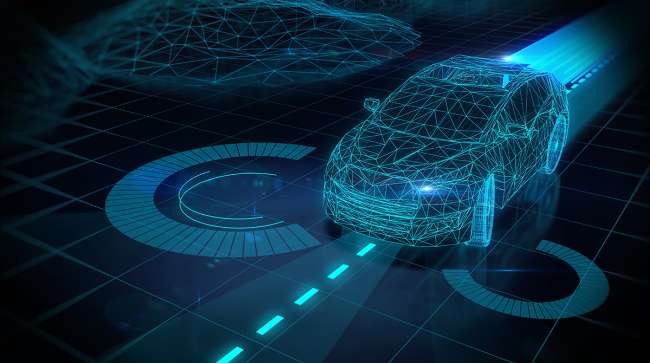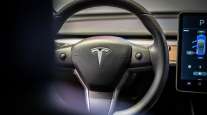'Smart Car' Technology May Make Roads Safer, but Some Fear Data Hacks

Autonomous vehicles are the wave of a rapidly approaching future that is already bringing increasing amounts of “smart” technology to cars and trucks, and could eventually make passengers of everyone in a vehicle.
Experts say smart cars will make the roads exponentially safer by taking the automobile’s weak link — its human driver — out of the equation.
Accidents would decline 90% by 2050, according to professional services company KPMG in a June report on the impact autonomous vehicles will have on the insurance industry.
This can be accomplished, according to those involved in the research, because artificial intelligence and machine learning would make the computer “brain” driving autonomous cars and trucks far better at making decisions than humans, whose errors today cause 94% of car crashes.
“The computer brain is programmed. You’re pretty sure reliably what it’s going to do. But the human brain? Who knows,” said Carla Bailo, assistant vice president for mobility research and business development at Ohio State University.
RELATED: Connected vehicle safety mandate hits unexpected pothole of opposition
OSU is pioneering research into autonomous vehicles, helping make Ohio a key player nationally in the development of technology that could revolutionize driving. Ohio State’s partners include the Ohio Department of Transportation, the Ohio Turnpike and the Transportation Research Center (TRC) in West Liberty, the nation’s largest independent automotive testing and proving ground.
“With our research we do have some of the really ‘out there,’ (things) that you wouldn’t even recognize as a vehicle in its current state,” said Joanna Pinkerton, TRC chief operating officer.
Game-changing technology
Fully-autonomous vehicle technology, along with the growing prevalence of high technology driver assistance features like automatic braking and lane departure warnings, are touted as game-changing ways to reduce roadway deaths.
Advocates say autonomous and “connected” vehicles, which can communicate with each other via the internet and wireless local networks, will also move more traffic more efficiently, reduce congestion and pollution and provide transportation to elderly and disabled people who cannot drive today’s conventional cars.
A range of capabilities and technologies encompass the term “autonomous,” but essentially it involves the car, truck or transit vehicle having the ability to navigate roadways, make key decisions on its own and have communication connectivity. In practice today, the autonomous cars on the road still have a person in the vehicle able to take control where necessary.
In the future, however, that may not even be needed. By 2050, or maybe sooner, fully-autonomous cars could be tooling down the road without a steering wheel, pedals for braking and acceleration or a driver.
“There are not any (autonomous vehicles) just running around by themselves. There’s always somebody in the car until we have confidence, or until the manufacturer has confidence that the car knows enough to go on its own,” Bailo said. “And nobody’s there yet.”
‘Not ready for prime time’
In many ways, though, the future is already here.
Tesla Inc. is selling cars with autopilot, allowing drivers to take hands off the wheel and car to navigate itself. Both Uber and Waymo, the company formed to run the self-driving car project started by Google in 2009, are testing autonomous vehicles on the road. And across the world automotive companies are working furiously to come up with the next big thing in autonomous technology.
“There are a lot of people who are really beginning to equate this with the advent of the horseless carriage and the emergence of both the telephone and the automotive industries,” said Randy Cole, executive director of the Ohio Turnpike. “It’s disruptive. It’s exciting. And it has the potential for great economic benefit and quality of life issues.”
But the promise of these advanced auto technologies comes with an array of challenges — both technological and practical.
“It’s not ready for prime time,” said veteran auto industry analyst David Cole, co-founder and chairman of AutoHarvest.org. “The concern at this point is that it is probably overhyped.”
RELATED: Self-driving cars bill in Senate veers into tricky truck debate
“Companies are saying ‘we’re going to have something here in 2021 or 2019. It’s leading the public to believe it’s really close,” he said. “The people who think, ‘I’m going to take a trip while sleeping in the back seat,’ that’s probably 20 or 30 years away.”
Tests of self-driving cars have largely gone well, though they haven’t been without setbacks. The Google/Waymo cars have been involved in a variety of crashes — often blamed on other drivers — and in 2016 a man was killed in a collision with a semi-truck in Florida while operating his Tesla Model S on autopilot. On Sept. 12 the National Transportation Safety Board blamed both drivers and the Tesla autopilot feature for the fatal crash, citing driver errors, over-reliance on automation, and a lack of vehicle safeguards.
“We appreciate the NTSB’s analysis of last year’s tragic accident and we will evaluate their recommendations as we continue to evolve our technology,” a Tesla spokesperson who declined to be named said in an emailed response. “We will also continue to be extremely clear with current and potential customers that Autopilot is not a fully self-driving technology and drivers need to remain attentive at all times.”
High tech autos also rely on Web-based technology, and their computers collect vast swaths of information, raising concerns about cyber security, privacy protection and ownership of data.
Safeguards are needed “to protect the data and to ensure that these products are not hacked,” Bailo said. “That bad guys won’t try to do something either to the vehicle or infrastructure, because either way it can create dire consequences.”
Potential problems
Some of the concerns about autonomous vehicles stem from how they might respond to road hazards and weather.
The so-called smart technology relies on an array of sensors — both on the car and in roadside equipment — that could get dirty, covered with snow or damaged. Some roadways don’t have clearly marked lanes, or can get obscured by snow, creating another hazard.
Manufacturers will need to determine how to program the vehicle to respond correctly to the many unexpected occurrences that can happen while driving, said David Cole, using the example of a deer running into the road. The conventional wisdom is to hit the deer, rather than swerve and potentially hit another car or a tree or flip into a ditch.
“But a child on a bike, that is a whole different story,” he said. “You’ve got to be able to sense and make good decisions really quickly. It’s when you have two choices, neither of which are very good, and you’ve got to pick one of them.”
Cole believes these types of technological issues will ultimately be resolved, but he also pointed out a potential legal pitfall for manufacturers. Most crashes today do not lead to a lawsuit against the company that built the car. But if there is no driver or the car is making key decisions for a driver, the manufacturer of that vehicle could be held liable, he said.
Interacting with traditional cars is one of the major challenges the manufacturers of autonomous vehicles face, said Bailo. Even if driverless cars become a common sight on the roads, plenty of drivers will be piloting their own vehicles for decades.
‘We want everybody to be on the same page’
As with any new technology, there is no consistency across the country as far as laws and regulations governing autonomous vehicles. For example, in Ohio it isn’t legal to operate a vehicle with no steering wheel. And only a few states even have laws allowing self-driving vehicles.
Nor have the auto and tech industries settled on standards so that vehicles all speak the same language.
“We don’t want to see a Beta vs. VHS-type battle in this. We want everybody to be on the same page,” said Matt Bruning, spokesman for ODOT. “Toyotas need to be able to speak to Hondas and Fords and Chevys.”
There also is the issue of jobs. If a semi-truck or transit vehicle no longer needs a driver, that could put people out of work, said Kara Deniz, spokesperson for the International Brotherhood of Teamsters.
RELATED: Drivers remain essential amid autonomous technology, trucking execs tell senate panel
Kevin Burch, president of Jet Express Trucking in Dayton and chairman of American Trucking Associations, doesn’t believe drivers should be worried.
“We are going to need human beings in the cabs of our trucks, I think, for a long time,” Burch said. “I will say this: The safety benefits and the technologies that we can put in these trucks are going to make these drivers more efficient and it’s going to make it a more attractive career.”
Public acceptance slow to come
Even as researchers move forward, large portions of the general public are concerned about the safety of “driverless or automated cars,” with 36% saying they have major concerns and 39% having minor concerns, according to a February poll by The National Safety Council, a non-profit group that focuses on stopping preventable deaths. 71% agreed that the idea of a car driving itself made them uncomfortable.
“Obviously the thought of letting go of the steering wheel when you are doing 70 miles an hour isn’t comforting,” said Bob Kazmierczak, director of automotive products for the American Automobile Association.
A 2016 AAA survey found that more than half of U.S. drivers feel less safe about sharing the road with a self-driving vehicle. Women were more likely than men to feel less safe.
And there is this: Many people love to drive and will be loathe to give it up.
Deborah Hersman, president and chief executive of the NSC said some manufacturers and people believe vehicles will always need to have a human operator to take over driving when necessary, while others see fully self-driving vehicles as the future of automobiles.
RELATED: Robots could replace 1.7 million American truckers in the next decade
“Regardless of the level of autonomy, we know that active safety system integration into the U.S. fleet will be more robust in years to come,” Hersman said in testimony before a U.S. Senate subcommittee considering an autonomous vehicle bill that passed in the U.S. House earlier this month.
“As these features continue to penetrate the driving world, we can expect to see changes in the very definition of the word ‘driver.’”
Although it may be awhile before driverless cars are populating the roadways in large numbers, advances in vehicle autonomy are coming quickly. Within five years, say experts, those vehicles could be used to navigate “geo-fenced” areas, such as college campuses or senior living communities.
The first of these will probably show up in places like Singapore, China, Tokyo and San Francisco “because their congestion and population growth are going to become unmanageable,” Bailo said.
Ohio’s role
Last November, an Uber-owned Volvo semi-truck hauled an ODOT brine tanker along Interstates 70 and 270 and U.S 33 from Columbus to Bellefontaine.
The driver took the wheel at construction zones and at the exit to Bellefontaine. Otherwise, technology guided the vehicle using GPS (accurate within one centimeter), radar, Light Detection and Ranging (LiDAR) features and camera sensors that kept the truck within the lines and accurately found the ODOT facility.
“From a witness perspective it was the most exciting boring drive I’ve ever had in my entire life,” said Andrew Bremer, ODOT deputy director of strategic initiatives, who rode along with the driver.
Ohio has a huge role in the testing being done on autonomous vehicles.
The state and OSU are jointly funding a $45 million, 540-acre Smart Mobility Advanced Research and Test Center (SMART) at the TRC for state-of-the-art testing of autonomous vehicles. It is expected to open next summer.
In Columbus, OSU’s Center for Automotive Research is also testing two autonomous Ford Fusion cars, working with manufacturers to perfect those systems, according to Bailo. And an autonomous shuttle — outfitted with an emergency stop button but no steering wheel or pedals — will be piloted on campus, she said.
ODOT is building a 35-mile “smart technology corridor” along U.S. 33 from Columbus to the TRC and a 23-mile corridor along I-270. Fiber optic cable and roadside “dedicated short-range communications units” will transmit information between vehicles and to ODOT and its vehicles, Bremer said.
The corridors will allow better testing of connected vehicle technology using actual road conditions, and also give ODOT a jump on common crash culprits like black ice. ODOT vehicles will be retrofitted with connected technology, so when a vehicle linked electronically through connected technology to other cars on the roadway hits ice it not only communicates that information to those vehicles but contacts ODOT, which can then deploy salt trucks to the area.
Cellular technology will be also be used to test a smart corridor on I- 90 from I-271 to the Pennsylvania state line, officials say.
The Ohio Turnpike has plans to deploy a fiber optic cable and sensor system along a 60-mile stretch in Lorain, Cuyahoga, Summit and Portage counties. Among the tests: truck “platooning,” which involves driving vehicles close together using vehicle-to-vehicle communication. Platooning could reduce congestion and save fuel due to decreased wind resistance, turnpike officials say.
New laws
Since 2012, 41 states and Washington, D.C., have considered autonomous vehicle legislation, according to the National Conference of State Legislatures. Twenty-one of them passed laws and governors in three others issued executive orders regarding autonomous vehicles, NCSL said.
In Ohio, a bill that would have banned self-driving cars failed to pass last year.
Nevada was the first state to legalize the operation of autonomous vehicles with no human operator and California approved a pilot program for the Bay Area that allows fully autonomous vehicles with no operator, steering wheel, or brake and accelerator pedal. Florida, Tennessee, Texas and Michigan are among states that currently allow operation of driverless autonomous vehicles, according to the NCSL.
U.S. Rep. Robert Latta, (R-Bowling Green), sponsored the SELF DRIVE Act in Congress, a bill facilitating autonomous vehicle development. It passed on a unanimous voice vote in the House in August and is now being considered by the U.S. Senate.
Latta said he wants to avoid having a patchwork of rules that don’t mesh with each other.
“This is not being driven by the federal government. This is a private sector initiative out there,” Latta said of the fast-moving industry. “We have to make sure as they go forward to make sure that the right laws and regulations are in place. We can’t have 50 states and the District of Columbia saying, ‘This is what we want.’”
Bailo, who retired from Nissan in 2014 as head of research and development for North and South America, said she used to be most excited about launching new vehicles.
That’s been rivaled now by advances in vehicle artificial intelligence, she said, which could mean fewer people die horrible deaths on the road, the elderly gain increased mobility and the disabled become freer to explore life.
Distributed by Tribune Content Agency, LLC




